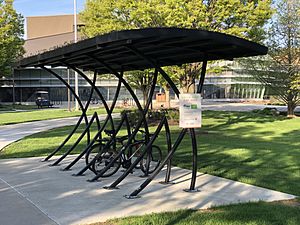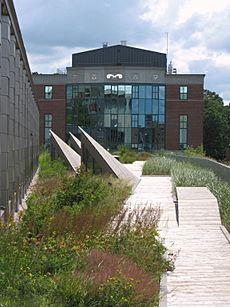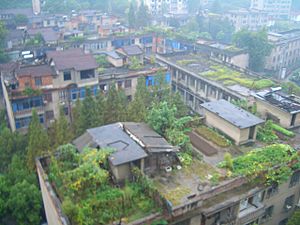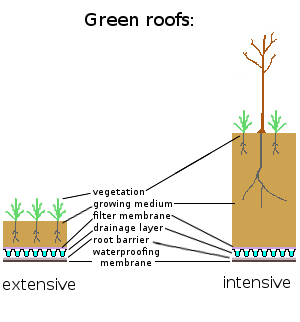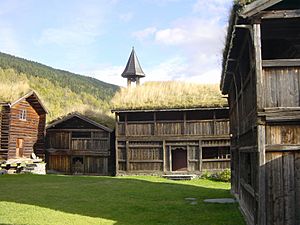Green roof facts for kids
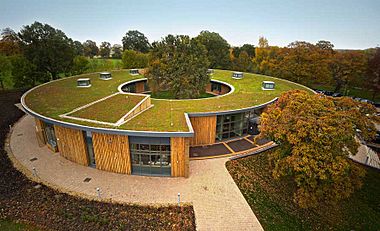

A green roof or living roof is a roof of a building that is partially or completely covered with vegetation and a growing medium, planted over a waterproofing membrane. It may also include additional layers such as a root barrier and drainage and irrigation systems. Container gardens on roofs, where plants are maintained in pots, are not generally considered to be true green roofs, although this is debated. Rooftop ponds are another form of green roofs which are used to treat greywater. Vegetation, soil, drainage layer, roof barrier and irrigation system constitute green roof.
Green roofs serve several purposes for a building, such as absorbing rainwater, providing insulation, creating a habitat for wildlife, increasing benevolence, and decreasing stress of the people around the roof by providing a more aesthetically pleasing landscape, and helping to lower urban air temperatures and mitigate the heat island effect. Green roofs are suitable for retrofit or redevelopment projects as well as new buildings and can be installed on small garages or larger industrial, commercial and municipal buildings. They effectively use the natural functions of plants to filter water and treat air in urban and suburban landscapes. There are two types of green roof: intensive roofs, which are thicker, with a minimum depth of 12.8 cm (5+1⁄16 in), and can support a wider variety of plants but are heavier and require more maintenance, and extensive roofs, which are shallow, ranging in depth from 2 to 12.7 cm (13⁄16 to 5 in), lighter than intensive green roofs, and require minimal maintenance.
The term green roof may also be used to indicate roofs that use some form of green technology, such as a cool roof, a roof with solar thermal collectors or photovoltaic panels. Green roofs are also referred to as eco-roofs, oikosteges, vegetated roofs, living roofs, greenroofs and VCPH (Horizontal Vegetated Complex Partitions)
Contents
Environmental benefits

Thermal reduction and energy conservation
Green roofs improve and reduce energy consumption. They can reduce heating by adding mass and thermal resistance value, also can reduce the heat island by increasing evapotranspiration. A 2005 study by Brad Bass of the University of Toronto showed that green roofs can also reduce heat loss and energy consumption in winter conditions. A modeling study found that adding green roofs to 50 percent of the available surfaces in downtown Toronto would cool the entire city by 0.1 to 0.8 °C (0.2 to 1.4 °F).
A green roof reduces cooling (by evaporative cooling) loads on a building by fifty to ninety percent, especially if it is glassed-in so as to act as a terrarium and passive solar heat reservoir.
A concentration of green roofs in an urban area can even reduce the city's average temperatures during the summer, combating the urban heat island effect. Traditional building materials soak up the sun's radiation and re-emit it as heat, making cities at least 4 °C (7.2 °F) hotter than surrounding areas. On Chicago's City Hall, by contrast, which features a green roof, roof temperatures on a hot day are typically 1.4–4.4 °C (2.5–7.9 °F) cooler than they are on traditionally roofed buildings nearby. Green roofs are becoming common in Chicago, as well as in Atlanta, Portland, and other United States cities, where their use is encouraged by regulations to combat the urban heat-island effect. Green roofs are a type of low impact development. In the case of Chicago, the city has passed codes offering incentives to builders who put green roofs on their buildings. The Chicago City Hall green roof is one of the earliest and most well-known examples of green roofs in the United States; it was planted as an experiment to determine the effects a green roof would have on the microclimate of the roof. Following this and other studies, it has now been estimated that if all the roofs in a major city were greened, urban temperatures could be reduced by as much as 7 °C (13 °F).
Water management
Green roofs can reduce stormwater runoff via water-wise gardening techniques. Green roofs play a significant role in retrofitting the Low Impact Development (LID) practices in urban areas. A study presented at the Green Roofs for Healthy Cities Conference in June 2004, cited by the EPA, found water runoff was reduced by over 75% during rainstorms. Water is stored by the roof's substrate and then taken up by the plants, from which it is returned to the atmosphere through transpiration and evaporation.
Green roofs decrease the total amount of runoff and slow the rate of runoff from the roof. It has been found that they can retain up to 75% of rainwater, gradually releasing it back into the atmosphere via condensation and transpiration, while retaining pollutants in their soil. Many green roofs are installed to comply with local regulations and government fees, often regarding stormwater runoff management. In areas with combined sewer-stormwater systems, heavy storms can overload the wastewater system and cause it to flood, dumping raw sewage into the local waterways. Often, phosphorus and nitrogen are in this category of environmentally harmful substances even though they are stimulating to the growth of plant life and agriculture. When these substances are added to a system, it can create mass biological activity since they are considered limiting factors of plant growth and by adding more of them to a system, it allows for more plant growth.
Ecological benefits
Green roofs create natural habitat as part of an urban wilderness. Even in high-rise urban settings as tall as 19 stories, it has been found that green roofs can attract beneficial insects, birds, bees and butterflies. A recent list of the bee species recorded from green roofs (worldwide) highlights both the diversity of species, but also the (expected) bias towards small ground-nesting species (Hofmann and Renner, 2017). Rooftop greenery complements wild areas by providing stepping stones for songbirds, migratory birds and other wildlife facing shortages of natural habitat.
Green roofs also serve as a green wall, filtering pollutants and carbon dioxide out of the air, helping to lower rates of diseases such as asthma. They can also filter pollutants and heavy metals out of rainwater.
Carbon sequestration
An additional environmental benefit of a green roof is the ability to sequester carbon. Carbon is the main component of plant matter and is naturally absorbed by plant tissue. The carbon is stored in the plant tissue and the soil substrate through plant litter and root exudates. A study on green roofs in Michigan and Maryland found the above ground biomass and below ground substrate stored on average between 168 g C m−2 and 107 g C m−2 . Variations occurred among the different species of plant used. Substrate carbon content averaged 913 g C m−2 and after the subtraction of the original carbon content the total sequestration was 378 g C m−2. The sequestration can be improved by changing plant species, increasing substrate depth, substrate composition, and management practices. In a study done in Michigan above ground sequestration ranged from 64 g C m−2 to 239 g C m−2 for S. acre and S album. Also, by increasing the substrate depth would allow for more area of carbon storage and diversify the types of plants with greater potential of carbon storage. The direct carbon sequestration techniques and methods can be measured and accounted for. Green roofs also indirectly reduce CO2 given off by power plants through their ability to insulate buildings. Buildings in the US account for 38% of the total carbon dioxide emissions. A model supported by the U.S. Department of Energy found a 2 percent reduction in electricity consumption and 9-11% reduction in natural gas when implementing green roofs.
Other
- Help to insulate a building for sound; the soil helps to block lower frequencies and the plants block higher frequencies
- If installed correctly many living roofs can contribute to LEED points
- Increase agricultural space
- Green roofs not only retain rainwater, but also moderate the temperature of the water and act as natural filters for any of the water that happens to run off.
Costs and financial benefits
A properly designed and installed extensive green-roof system can cost $108–$248/m2 ($10–$23/sq ft) while an intensive green roof costs $355–$2,368/m2 ($33–$220/sq ft) However, since most of the materials used to build the green roof can be salvaged, it is estimated that the cost of replacing a green roof is generally one third of the initial installation costs.
With the initial cost of installing a green roof in mind, there are many financial benefits that accompany green roofing.
- Green roofing can extend the lifespan of a roof by over 200% by covering the waterproofing membrane with growing medium and vegetation, this shields the membrane from ultra-violet radiation and physical damage. Further, Penn State University's Green Roof Research Center expects the lifespan of a roof to increase by as much as three times after greening the roof.
- It is estimated that the installation of a green roof could increase the real estate value of an average house by about 7%.
- Reduction in energy use is an important property of green roofing. By improving the thermal performance of a roof, green roofing allows buildings to better retain their heat during the cooler winter months while reflecting and absorbing solar radiation during the hotter summer months, allowing buildings to remain cooler. A study conducted by Environment Canada found a 26% reduction in summer cooling needs and a 26% reduction in winter heat losses when a green roof is used. With respect to hotter summer weather, green roofing is able to reduce the solar heating of a building by reflecting 27% of solar radiation, absorbing 60% by the vegetation through photosynthesis and evapotranspiration, and absorbing the remaining 13% into the growing medium. Such mitigation of solar radiation has been found to reduce building temperatures by up to 20 °C (36 °F) and reduce energy needs for air-conditioning by 25% to 80%. This reduction in energy required to cool a building in the summer is accompanied by a reduction in energy required to heat a building in the winter, thus reducing the energy requirements of the building year-round which allows the building temperature to be controlled at a lower cost.
- Depending on the region in which a green roof is installed, incentives may be available in the form of stormwater tax reduction, grants, or rebates. The regions where these incentives will most likely be found are areas where failing storm water management infrastructure is in place, urban heat island effect has significantly increased the local air temperature, or areas where environmental contaminants in the storm water runoff is of great concern. An example of such an incentive is a one-year property tax credit is available in New York City, since 2009, for property owners who green at least 50% of their roof area.
Disadvantages
The main disadvantage of green roofs is that the initial cost of installing a green roof can be double that of a normal roof. Depending on what kind of green roof it is, the maintenance costs could be higher, but some types of green roof have little or no ongoing cost. Some kinds of green roofs also place higher demands on the waterproofing system of the structure, both because water is retained on the roof and due to the possibility of roots penetrating the waterproof membrane. Another disadvantage is that the wildlife they attract may include pest insects which could easily infiltrate a residential building through open windows.
The additional mass of the soil substrate and retained water places a large strain on the structural support of a building. This makes it unlikely for intensive green roofs to become widely implemented due to a lack of buildings that are able to support such a large amount of added weight as well as the added cost of reinforcing buildings to be able to support such weight. Some types of green roofs do have more demanding structural standards especially in seismic regions of the world. Some existing buildings cannot be retrofitted with certain kinds of green roofs because of the weight load of the substrate and vegetation exceeds permitted static loading. The weight of a green roof caused the collapse of a large sports hall roof in Hong Kong in 2016. In the wake of the disaster numerous other green roofs around the territory were removed.
Green roofs require significantly more maintenance and maintenance energy compared to a standard roof. Standard maintenance include removing debris, controlling weeds, deadhead trimming, checking moisture levels, and fertilizing. The maintenance energy use for green roofs has many variables including: climate, intensity of rainfall, type of building, type of vegetation, and external coatings. The most significant effect comes from scarce rainfall which will increase the maintenance energy due to the watering required. During a 10-year roof maintenance cycle a house with a green roof requires more retrofit embodied energy than a house with a white roof. The individual components of a green roof have CO2 implications during the manufacturing process have additional implications compared to a conventional roof. The embodied energy for green roof components are 23.6 kg/m2 (5 pounds per square foot) CO2 of green roof. This value is equivalent to 6448 g C m−2 which is significantly greater than 378 g C m−2.
Both sod roofs and LWA-based (Lightweight Aggregates) roofs have been found to have a negative impact on the quality of their resulting runoff.
Types
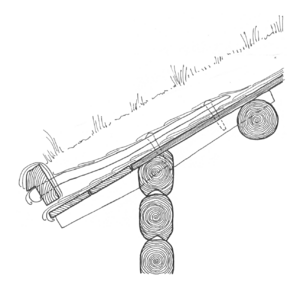
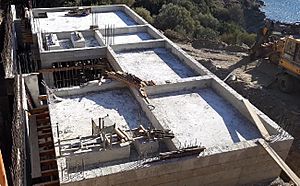
Green roofs can be categorized as intensive, semi-intensive, or extensive, depending on the depth of planting medium and the amount of maintenance they need. Extensive green roofs traditionally support 50–120 kg/m2 (10–25 pounds per square foot) of vegetation while intensive roofs support 390–730 kg/m2 (80–150 pounds per square foot) of vegetation. Traditional roof gardens, which require a reasonable depth of soil to grow large plants or conventional lawns, are considered intensive because they are labour-intensive, requiring irrigation, feeding, and other maintenance. Intensive roofs are more park-like with easy access and may include anything from kitchen herbs to shrubs and small trees. Extensive green roofs, by contrast, are designed to be virtually self-sustaining and should require only a minimum of maintenance, perhaps a once-yearly weeding or an application of slow-release fertiliser to boost growth. Extensive roofs are usually only accessed for maintenance. They can be established on a very thin layer of soil (most use specially formulated composts): even a thin layer of rockwool laid directly onto a watertight roof can support a planting of Sedum species and mosses. Some green roof designs incorporate both intensive and extensive elements. To protect the roof, a waterproofing membrane is often used, which is manufactured to remain watertight in extreme conditions including constant dampness, ponding water, high and low alkaline conditions and exposure to plant roots, fungi and bacterial organisms.
Advances in green roof technology have led to the development of new systems that do not fit into the traditional classification of green roof types. Comprehensive green roofs bring the most advantageous qualities of extensive and intensive green roofs together. Comprehensive green roofs support plant varieties typically seen in intensive green roofs at the depth and weight of an extensive green roof system.
Another important distinction is between pitched green roofs and flat green roofs. Pitched sod roofs, a traditional feature of many Scandinavian buildings, tend to be of a simpler design than flat green roofs. This is because the pitch of the roof reduces the risk of water penetrating through the roof structure, allowing the use of fewer waterproofing and drainage layers.
History
In ancient times green roofs consisted of cave-like structures or sod roofs covered with earth and plants commonly used for agriculture, dwelling, and ceremonial purposes. These early shelters provided protection from the elements, good insulation during the winter months, and a cool location in the summer. Unfortunately for modern conveniences, these were neither waterproof nor was there any system to keep out unwanted burrowing wildlife.
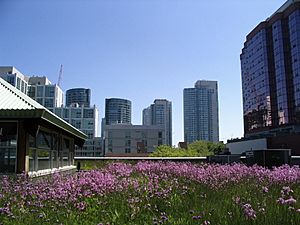
Modern green roofs, which are made of a system of manufactured layers deliberately placed over roofs to support growing medium and vegetation, are a relatively new phenomenon. However, green roofs or sod roofs in northern Scandinavia have been around for centuries. The modern trend started when green roofs were developed in Germany in the 1960s, and has since spread to many countries. Today, it is estimated that about 10% of all German roofs have been "greened".
A number of European Countries have very active associations promoting green roofs, including Germany, Switzerland, the Netherlands, Norway, Italy, Austria, Hungary, Sweden, the UK, and Greece. Germany was the first country to start developing green roof systems and market them on a large scale. The City of Linz in Austria has been paying developers to install green roofs since 1983, and in Switzerland it has been a federal law since the late 1990s. In the UK, their uptake has been slow, but a number of cities have developed policies to encourage their use, notably London and Sheffield.
Green roofs are also becoming increasingly popular in North America, although they are not as common as in some parts of Europe. Numerous North American cities offer tax incentives to developers who integrate green roofs in their buildings. Toronto and San Francisco legally mandate new buildings to include green roofs
Rooftop water purification is also being implemented in green roofs. These forms of green roofs are actually treatment ponds built into the rooftops. They are built either from a simple substrate (as being done in Dongtan) or with plant-based ponds. Plants used include calamus, Menyanthes trifoliata, Mentha aquatica, etc.)
Several studies have been carried out in Germany since the 1970s. Berlin is one of the most important centers of green roof research in Germany. Particularly in the last 10 years, much more research has begun. About ten green roof research centers exist in the US and activities exist in about 40 countries. In a recent study on the impacts of green infrastructure, in particular green roofs in the Greater Manchester area, researchers found that adding green roofs can help keep temperatures down, particularly in urban areas: "adding green roofs to all buildings can have a dramatic effect on maximum surface temperatures, keeping temperatures below the 1961–1990 current form case for all time periods and emissions scenarios. Roof greening makes the biggest difference…where the building proportion is high and the evaporative fraction is low. Thus, the largest difference was made in the town centers".
Brown roofs
Industrial brownfield sites can be valuable ecosystems, supporting rare species of plants, animals and invertebrates. Increasingly in demand for redevelopment, these habitats are under threat. "Brown roofs", also known as "biodiverse roofs", can partly mitigate this loss of habitat by covering the flat roofs of new developments with a layer of locally sourced material. Construction techniques for brown roofs are typically similar to those used to create flat green roofs, the main difference being the choice of growing medium (usually locally sourced rubble, gravel, soil, etc...) to meet a specific biodiversity objective. In Switzerland, it is common to use alluvial gravels from the foundations; in London, a mix of brick rubble and some concrete has been used. The original idea was to allow the roofs to self-colonise with plants, but they are sometimes seeded to increase their biodiversity potential in the short term. Such practices are derided by purists. The roofs are colonised by spiders and insects (many of which are becoming extremely rare in the UK as such sites are developed) and provide a feeding site for insectivorous birds. Laban, a centre for contemporary dance in London, has a brown roof specifically designed to encourage the nationally rare black redstart. A green roof, 160 m (520 ft) above ground level, and claimed to be the highest in the UK and Europe "and probably in the world" to act as nature reserve, is on the Barclays Bank HQ in Canary Wharf. Designed combining the principles of green and brown roofs, it is already home to a range of rare invertebrates.
ASLA Award Green Roof Projects

2017 Award: Seeding Green Roofs for Greater Biodiversity and Lower Costs, Lincoln, NE, USA. Richard Sutton
2013 Award: Green Roof Innovation Testing Laboratory, Toronto, Ontario, Canada. John H. Daniels, Brooklyn Botanic Garden Visitors Center, Brooklyn. HMWhite, and NYC Parks Green Roof: A Living Laboratory for Innovative Green Roof Design, New York, NY. NYC Parks
2012 Award: Lafayette Greens: Urban Agriculture, Urban Fabric, Urban Sustainability, Detroit. Kenneth Weikal Landscape Architecture 200 Fifth Avenue, NYC. Landworks Studio, Inc.
2011 Award: Manassas Park Elementary School Landscape, Manassas Park, VA. Siteworks]
2009 Award: California Academy of Sciences, San Francisco, CA. SWA Group, Changi Airport Terminal 3 Interior Landscape, Singapore. Tierra Design (S) Pte Ltd, Corporate Headquarters, San Francisco, CA. OLIN, Macallen Building, South Boston, MA. Landworks Studio, Inc., and Museo del Acero Horno3, Monterrey, Mexico. Surfacedesign Inc.+ Harari arquitectos
2008 Award: Gannett/USA Today Headquarters, McLean, Virginia. Michael Vergason Landscape Architects, Ltd.
2007 Award: Washington Mutual Center Roof Garden, Seattle, Washington. Phillips Farevaag Smallenberg
2002 Award: Chicago City Hall Green Roof, Chicago, Illinois. David Yocca
Images for kids
-
An intensive roof garden in New York City
See also
 In Spanish: Techo verde para niños
In Spanish: Techo verde para niños


